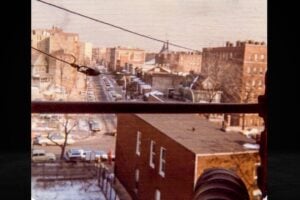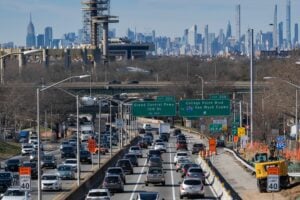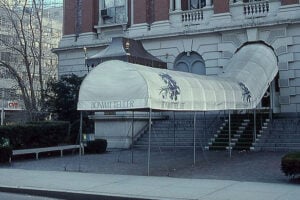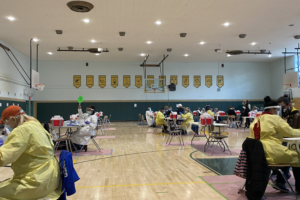
Feature Photo: Meadowlandsracetrack, CC BY-SA 4.0 <https://creativecommons.org/licenses/by-sa/4.0>, via Wikimedia Commons
The history of the Meadowlands Racetrack officially began on September 1, 1976, with its first harness race. On September 6, 1977, it was thoroughbred racing. Today, the focus on what’s now technically called Meadowlands Racing & Entertainment witnesses a season of thoroughbred racing during the fall season while the rest of the year the track is dedicated to harness racing. Located in East Rutherford, New Jersey, this venue has become a staple in North American harness racing.
Racing with the Moon
Long before Meadowlands Racetrack went from concept to reality, there was a certain catchphrase that became popularized for the first time in 1941. Vaughn Monroe’s “Racing with the Moon” became an advertising slogan for the New Jersey-based racetrack not long after it first opened. It was used to promote the thoroughbred racing that was held there. The ad campaign was later replaced with a new slogan, “It’s All About Being Here – The Meadowlands!”
The main track at the Meadowlands has a one-mile circumference of dirt. Inside it, there is a seven-furlong turf course exclusively used for thoroughbred racing. The overall design of the track shares the same characteristics of similar racetracks throughout the United States. For the most part, the racing that takes place there is held during the evening. The only key difference is the manmade lake in the middle of the track that resembles the shape of New Jersey as a state.
Aside from catchy slogans, the infamous announcement of “…and down the stretch they come” originated from Dave Johnson as he infamously called the Triple Crown races as part of his trademark. He was the Meadowlands Racetrack’s first announcer as they began a one-hundred-night thoroughbred race that began on September 6, 1977.
Making Impressions
Also referred to as “Big M,” the racetrack is noted for sweeping curves and wide stretches, making this the ideal track for harness racing. When it opened up for the first time in 1976, the quickest harness race time was set at 1:553 by Rambling Willie. There were 42,133 spectators present at the facility to watch this historical moment take place. This was followed by the first Meadowlands Pace that was held in 1977 and won by Escort. Since then, this has become an annual event. Woodrow Wilson was also introduced for the first time at the racetrack at the same time, witnessing No No Yankee earn the first win in what also became an annual racing event.
The track has also served as the first leg of the Trotting Triple Crown since 1981 with the Hambletonian after it relocated to what was recognized as the best venue to hold its annual event. Starting in 2015, it has been scheduled during the same racing program as the infamous Cane Pace and its first leg of the harness Racing’s Pacing Triple Crown.
Located at the Meadowlands Sports Complex, the racetrack accompanies American Dream Meadowlands, Meadowlands Arena (also known as Izod Center), and MetLife Stadium as one of the venues owned and operated by the New Jersey Sports and Exposition Authority. Among the four facilities at the Meadowlands, the racetrack currently stands as the oldest. The Quest Diagnostics and Training Center is also at the Meadowlands Complex, serving as the official headquarters of the New York Giants.
When the Meadowlands was nicknamed The Big M, the idea was to attract the New York crowd by playing of Aqueduct Racetrack’s own nickname, The Big A. As a night racing venue, the Meadowlands was at the top of its game by holding its major stakes races on Thursday nights instead of competing on the weekends with New York’s tracks. When the Meadowlands Cup began as its signature stake, it started out as a ten-furlong race on the dirt track. The first to win it was Pay Tribute in 1977. It was trained by Ron McAnally and driven by Angel Cordero, Jr., a couple of Hall of Famers that earned names for themselves as legends. Cordero, Jr. won the Meadowlands Cup three more times going into the 1980s. After him, it was John Velazquez who also won the cup four times as a driver.
Until 2009, the Meadowlands Cup was held at the New Jersey track before it was renamed Monmouth Stakes Cup and relocated to Monmouth Park in Oceanport, New Jersey. It was during this time the popularity of Meadowlands Racetrack saw only an average of forty racing days with not much more than three thousand spectators in attendance.
KO’d
On June 11, 1982, the Meadowlands set a new crowd record of 52,794 people as they came to watch the racing and the simulcast of a boxing event that featured Gerry Cooney duke it out with Larry Holmes. This was one of the most anticipated fights at the time as the WBC heavyweight champion Holmes sought to put an end to Cooney’s winning streak after he defeated former WBC champ, Ken Norton. Cooney’s victory at Madison Square Garden in 1981 put him as the top contender to challenge Holmes for the championship title.
Don King’s promotional campaign to hype up the excitement of a boxing match that actually took place in Las Vegas, Nevada, prompted racetracks like Meadowlands to simulcast the event as it happened. It wasn’t until a week later HBO aired it for public viewing. This was a fight for the ages that lasted thirteen rounds before it was determined Cooney was unable to continue. For boxing fans in New Jersey, being at the Meadowlands Racetrack was the closest thing to sports heaven as it gets. Boxing and racing as a dual event, along with the betting involved, felt pivotal at the time.
However, the controversy of simulcasting raged on to the point that the state of New Jersey declared simulating to be unconstitutional on March 28, 1985. It was discontinued on November 5 but this unpopular decision made by the state government brought about a referendum that had the voters reinstate it on December 3.
Game Changers
When the Meadowlands opened up in 1976, its harness track changed the face of this brand of horseracing forever. Among the New Jersey locals, the site’s been referred to as the Big M due to its one-mile harness track that attracted so many of the best harness horses, drivers, and trainers in North America. As far as harness racing was concerned, the Meadowlands was the “it” place to be.
The track itself was designed out of necessity as the early 1970s witnessed harness races met with certain limitations that didn’t seem to make it fair. Until reaching the final stretch, the horses had no choice but to race in a single file. As far as the racers and spectators were concerned, it didn’t really become a race until the homestretch. The design of the Big M allowed a new breed of driver steps into the spotlight. They were called catch drivers.
In order to become a catch driver, the combination of athletic ability, weight, and youth played a key factor. This was necessary to keep up with the horses as they were now able to run faster on a track accommodating enough to do so. Among these drivers, John Campbell was at the top as the most dominant force to reckon with as he was lightweight and strong enough to handle even the most powerful horses ever to grace the sport of harness racing.
Making History
During the 1986 fall season, the eleven-year-old thoroughbred John Henry made his final appearance at the Meadowlands Racetrack while it celebrated its tenth anniversary. This Hall of Famer was a gelding that won what was a record winning of $6.5 million USD in the eighty-three races it ran. This came two years after he won his final race, the Ballentine Scotch Classic in what was an explosive late rush before retiring to the Kentucky Horse Park in Lexington. John Henry was the same horse that won the Eclipse Award seven times.
In 1984, he was the oldest horse to win the Eclipse Award for Horse of the Year at nine years old. It was also that year he became the oldest horse to win the prestigious Arlington Million. It was his second win since its inaugural race in 1981. He remains the only horse to win this race twice. In 1990, he was inducted into the National Museum of Racing and Hall of Fame.
Six years after the Hambletonian moved its harness racing event to Meadowlands, a driver name John Campbell began a winning streak that had him dominate the sport. On August 8, 1987, he drove Mack Lobell to their first victory. The legendary horse went on to become a two-time Horse of the Year honoree. As for Campbell, this was his favorite horse to ride with as a racer. In 1988, it was with Ambro Goal, and in 1990, Harmonious.
On the evening of Meadowlands Pace in 1995, there was a total wager amount of $6,771,499.00 USD. This became a new record in the harness racing industry. The Hambletonian Day itself produced the second-highest handle at $5,828,749.00 USD. This was beaten in 1998 at $6.5 million. This was the Hambletonian race that witnessed John Campbell earn his fifth win with the seemingly unbeatable Muscle Yankee.
The Hambletonian
For the Meadowlands, the Hambletonian Stakes moving to New Jersey’s racetrack was a big deal. The history of this premier harness racing event has its roots starting at the New York State Fair in Syracuse in 1926. In 1927, the race was moved to Lexington, Kentucky due to a rainout. It returned to Syracuse in 1928, then back to Lexington in 1929. In 1930, Good Time Park in Goshen, New York became the new host of the Hambletonian until 1956. During that time frame, the race had to be held at the Empire City Race Track in 1943 due to wartime gas rationing.
From 1957 until 1980, the Hambletonian was held at Illinois’s Du Quoin State Fair. After it no longer held the rights to host the race anymore, Hambletonian was moved back east, this time to the Meadowlands Racetrack in East Rutherford, New Jersey. This major American harness racing event features three-year-old trotting horses that were named in honor of Hambletonian 10. He was a foundation sire of the standardbred horse breed. Also known as the father of the American Trotter, the legacy of that horse was brought to the first of the Triple Crown of Harness Racing for Trotters.
Adding to the rich history of the Hambletonian and the Meadowlands Racetrack is John Campbell. This legendary driver dominated harness racing from 1987 to 2006 which witnessed a total of six wins in this prestigious race. To this day, that record has yet to be broken. Born on April 8, 1955, in Ailsa Craig Ontario, the Canadian driver deservedly earned his place in the U.S. Harness Racing Hall of Fame in 1990. He was the youngest driver to be inducted at just thirty-five years old. He was also inducted into the Canadian Horse Racing Hall of Fame, and in 2009, his name was added to Canada’s Sports Hall of Fame.
Campbell himself came from a history of standardbred horsemen, a legacy that continues through his sons. As good as his offspring have been, many consider John Campbell the greatest reinsman of all time. His purse earnings as a driver exceed what current jockeys and drivers have earned so far. The vast majority of the money won in purses came from the Meadowlands Racetrack. To this day, both he and the Meadowlands remain on top of all the North American Tracks that cater to horseracing.
Big Mack Attack
The first of the Hambletonian Stakes wins John Campbell earned took place during the summer of 1987, racing a Standardbred named Mack Lobell. Deemed as the “Mack Attack’ in the media, this dynamic duo literally heightened the popularity of Meadowlands Racetrack to a whole new level. The two also heightened the popularity of harness racing at the same time. For Lobell, he set a world record for two-year-old trotters at 1:55:3, as well as a track record of 1:54 at the Meadowlands in its Beacon Course Trot. Lobell himself was something of an anomaly as he was sired by another Standardbred legend, Mystic Park.
Park was a standardbred that was the 1982 favorite to win the Hambletonian but met with a combination of performance and physical conditions that prevented him from doing so. After he retired from racing, he was diagnosed with a medical condition that once upon a time suggested he wouldn’t be able to survive it. As it turned out he did. Strong enough to stand as a stud, he sired Mack Lobell who would pull off in 1987 what he couldn’t five years prior, thanks to John Campbell. As far as Campbell was concerned, of all the horses he drove as a racer, Mack Lobell was the best.
Prior to Campbell, Mack Lobell’s performance as a racer was unstable. Part of the problem was his speed which most drivers couldn’t seem to handle. During the 1987 Hambletonian, the combined efforts of Campbell and Lobell saw a two-heat world record set at 3:47.3. How the race was won in the first heat at 1:54 and the second at 1:53.3 witnessed Campbell move Mack Lobell to the front before the quarter, holding back mid-race challengers, before speeding down the home stretch in what the two made look so easy.
After this race, Mack Lobell was voted Harness Horse of the Year for 1987. In 1988, he won this as a four-year-old. Sired by the youngest stallion ever to produce a Hambletonian champion, Mack Lobell shares Campbell’s recognition in the United States Harness Racing Hall of Fame. Desired as a stud by Swedish trainer and breeder, John-Eric Magnusson, he was sold and moved overseas. While there, it was realized his championship racing days weren’t over yet. He won the Elitoppet in Sweden in 1988, then again in 1990. This was followed by a series of wins throughout Europe. Even when he returned to the U.S. for the occasional race, the winning streaks continued. All of that came to an end when the horse died in 2016 at thirty-two years of age. Unlike his father, Mystic Park, he didn’t sire any offspring to carry on the family legacy.
Campbell’s Streak
The 1988 Hambletonian Stakes witnessed John Campbell race to his second victory with Armbro Goal. In 1990, he earned his third with Harmonious. As for the race in 1995, he was the driver of Tagliabue while his son, Jim Campbell, was the trainer. This became Campbell’s fourth win at Meadowland’s most prestigious harness racing event. In 1998, Campbell’s fifth victory raced Muscles Yankee across the finish line even faster than what he and Mack Lobell accomplished in 1987. At 1:52 2/5, it was the second-fastest track record raced in the Hambletonian Stakes. Continentalvictory raced with driver Michel Lachance, who had the fastest record at that time at 1:52 1/5 as they won this race in 1996.
In 2006, John Campbell’s sixth Hambletonian Stakes victory was made possible with Glidemaster. For Campbell, as well as the Meadowlands, what a way to carry on a legacy at the track. Just like Mack Lobell, Glidemaster became a United States Harness of the Year by the U.S. Trotting Association. Born as a Canadian, just like Campbell, Glidemaster became the fifth horse from that nation to earn a victory at the Hambletonian Stakes.
Aside from the Hambletonian, John Campbell’s winning streak as a driver made him a legend among horseracing fans. Although born Canadian, he became a resident of River Vale, New Jersey. His connection with harness racing fans, as well as the Meadowlands continues, even after he officially retired.
The man is also in the record books that include his 10,000 wins as a driver on July 12, 2008, after racing Share the Delight in the sixth race that was held that day. By the time he retired in 2017, he had 10,688 victories to his name, as well as a purse-winning total of almost three hundred million dollars.
Glidemaster
What makes Glidemaster stand out was the fact he had a puncture wound in his foot after stepping on a nail. It was severe enough to be considered unfit for racing. However, just before elimination, he was able to race to a second-place finish. This was enough to qualify for the final that resulted in winning the Hambletonian at Meadowlands. That victory led him to a Trotting Triple Crown, the first trotter to do so since 1972. This memorable journey began at the Meadowlands as the first leg that led to a win at the Kentucky Futurity at The Red Mile. The final leg, held at Yonkers Raceway, witnessed Glidemaster win the Yonkers Trot. He became the second horse from Blair Burgess’s stable to win the Hambletonian in Meadowlands. In 2003, Amigo Hall pulled off one of the biggest upsets in the history of harness racing at 27-1.
Glidemaster was the same horse who later sired Maven, the horse who won the Breeders Crown in 2013. The race itself has been held at the Meadowlands Racetrack, off and on, since 1987. The year this mare earned her victory was held at Mohegan Sun at Pocono Downs, Pennsylvania.
Eyeballing the Prize
Bruton Smith of Lowe’s Motor Speedway has been looking to Meadowlands Racetrack as a potential NASCAR short track during its events held in the New York City area. He began making several attempts to acquire the property in the late 1990s. Going into 2010, there was consideration made by the New Jersey government to close the track altogether and either sell it off as commercial development or use it to cater to NASCAR.
Today, the venue is owned by New Meadowlands Racetrack LLC and operated by the New Jersey Sports and Exposition Authority. This came after the New Jersey Sports and Exposition Authority privatized it as a business to Jeffrey Gural of Newmark Knight Frank in 2011. That privatization included over one hundred million dollars worth of renovations. A new grandstand was put in place of the new one. At one point, this was used as an event space when it held the Super Bowl in 2013.
Once it was ready, the new grandstand opened up for simulcasting on November 18, 2013. After this, it hosted its first harness race five days later. Under Gural and The Hard Rock, this 180,000 square-foot complex featured four floors and a track apron that could accommodate up to ten thousand spectators.
Meadowlands Today
The Meadowlands continues to serve as an ideal track for harness racing events even though the face of this sport has changed considerably since the height of its popularity. Year after year, the epic Breeders’ Crown, Hambletonian, and Meadowlands Pace continue to make their presence felt at the racetrack in New Jersey. When not racing horses around the track, it has also served as the perfect venue for carnivals and outdoor concerts. One such concert was held on June 28, 2015. This multi-band performance was Life In Color NYNJ: World’s Largest Paint Party 2015 which featured Ansolo, Bro Safari, Showtek, TJR, and Zaxx.
Starting in 2018, the Meadowlands brought in Paddy Power Betfair as a sportsbook at the track after New Jersey legalized sports betting. Under the brand of a daily fantasy sports service called FanDuel, it has been handling the track’s betting practices as an on-site service, as well as online. As of 2021, it has hosted over one hundred Breeders Crown Finals, more than any other racetrack of its kind.
The combination of sports betting and big-screen excitement in New Jersey was proven to be a success in 1982 when Holmes and Cooney exchanged blows in a boxing match that’s still a conversation piece to this day. What FanDuel Sportsbook has done is capitalize on the state’s gambling laws to place Meadowlands Racetrack on the map as a world-class entertainment venue as well.
Resources
https://www.bettinghorses.com/racetracks/MED/meadowlands_racetrack.html
https://www.horseracing-info.com/meadowlands-horseracing.html|
https://www.concertarchives.org/venues/meadowlands-racetrack–727654
https://www.nytimes.com/1987/08/09/sports/harness-racing-mack-lobell-captures-hambletonian.html
https://ustrottingnews.com/maven-is-impressive-in-capturing-breeders-crown-mare-trot/
https://www.horseracingnation.com/blogs/Monmouth/Remembering_the_Meadowlands_Racetrack_123
https://www.britannica.com/biography/John-D-Campbell





























